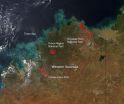(Press-News.org) In one of the most comprehensive multi-observatory galaxy surveys yet, astronomers find that galaxies like our Milky Way underwent a stellar "baby boom," churning out stars at a prodigious rate, about 30 times faster than today.
Our sun, however, is a late "boomer." The Milky Way's star-birthing frenzy peaked 10 billion years ago, but our sun was late for the party, not forming until roughly 5 billion years ago. By that time the star formation rate in our galaxy had plunged to a trickle.
Missing the party, however, may not have been so bad. The sun's late appearance may actually have fostered the growth of our solar system's planets. Elements heavier than hydrogen and helium were more abundant later in the star-forming boom as more massive stars ended their lives early and enriched the galaxy with material that served as the building blocks of planets and even life on Earth.
Astronomers don't have baby pictures of our Milky Way's formative years to trace the history of stellar growth so they studied galaxies similar in mass to our Milky Way, found in deep surveys of the universe. The farther into the universe astronomers look, the further back in time they are seeing, because starlight from long ago is just arriving at Earth now. From those surveys, stretching back in time more than 10 billion years, researchers assembled an album of images containing nearly 2,000 snapshots of Milky Way-like galaxies.
The new census provides the most complete picture yet of how galaxies like the Milky Way grew over the past 10 billion years into today's majestic spiral galaxies. The multi-wavelength study spans ultraviolet to far-infrared light, combining observations from NASA's Hubble and Spitzer space telescopes, the European Space Agency's Herschel Space Observatory, and ground-based telescopes, including the Magellan Baade Telescope at the Las Campanas Observatory in Chile.
"This study allows us to see what the Milky Way may have looked like in the past," said Casey Papovich of Texas A&M University in College Station, lead author on the paper that describes the study's results. "It shows that these galaxies underwent a big change in the mass of its stars over the past 10 billion years, bulking up by a factor of 10, which confirms theories about their growth. And most of that stellar-mass growth happened within the first 5 billion years of their birth."
The new analysis reinforces earlier research which showed that Milky Way-like galaxies began as small clumps of stars. The galaxies swallowed large amounts of gas that ignited a firestorm of star birth.
The study reveals a strong correlation between the galaxies' star formation and growth in stellar mass. So, when the galaxies slow down making stars, their growth decreases as well. "I think the evidence suggests that we can account for the majority of the buildup of a Milky Way-like galaxy through its star formation," Papovich said. "When we calculate the star-formation rate of a Milky Way-like galaxy in the past and add up all the stars it would have produced, it is pretty consistent with the mass growth we expected. To me, that means we're able to understand the growth of the 'average' galaxy with the mass of a Milky Way galaxy."
The astronomers selected the Milky Way-like progenitors by sifting through more than 24,000 galaxies in the entire catalogs of the Cosmic Assembly Near-infrared Deep Extragalactic Legacy Survey (CANDELS), taken with Hubble, and the FourStar Galaxy Evolution Survey (ZFOURGE), made with the Magellan telescope.
They used the ZFOURGE, CANDELS, and Spitzer near-infrared data to study the galaxy stellar masses. The Hubble images from the CANDELS survey also provided structural information about galaxy sizes and how they evolved. Far-infrared light observations from Spitzer and Herschel helped the astronomers trace the star-formation rate.
INFORMATION:
The team's results will appear in the April 9 issue of The Astrophysical Journal.
For images and more information about the Hubble Space Telescope, visit: http://www.nasa.gov/hubble or http://hubblesite.org/news/2015/11
New evidence published in Science by Smithsonian geologists dates the closure of an ancient seaway at 13 to 15 million years ago and challenges accepted theories about the rise of the Isthmus of Panama and its impact on world climate and animal migrations.
A team analyzed zircon grains from rocks representing an ancient sea and riverbeds in northwestern South America. The team was led by Camilo Montes, former director of the Panama Geology Project at the Smithsonian Tropical Research Institute. He is now at the Universidad de los Andes.
The team's new date for closure ...
New research shows that Lake Erie's dead zones are actually quite active, greatly affecting fish distributions, catch rates and the effectiveness of fishing gear.
Scientists with the U.S. Geological Survey, the Illinois-Indiana Sea Grant and partners recently found that dead zones caused by hypoxia, the depletion of oxygen in water, are unexpectedly variable in Lake Erie, sometimes disappearing and reemerging elsewhere in the matter of hours. They also found that fish like yellow perch cluster at the edges of these areas. The discovery of erratic dead zones can help ...
PITTSBURGH-- Three leading cognitive scientists from Carnegie Mellon University are questioning the gender representation of invited contributors in the special February 2015 issue, "The Changing Face of Cognition," published by the international journal Cognition.
Cognition, a highly regarded scientific journal, publishes theoretical and experimental papers on the study of the mind - a topic that has been a research strength of CMU for decades and that is receiving intense focus through the federal government's BRAIN Initiative.
In an opinion piece to appear in Cognition, ...
A study in the scientific journal BMC Health Services Research shows that early and guideline adherent physical therapy following an initial episode of acute, nonspecific low back pain (LBP) resulted in substantially lower costs and reduced use of health care resources over a 2-year period.
Physical therapist researchers John D. Childs, PT, PhD, et al analyzed 122,723 patients who went to a primary care physician following an initial LBP episode and received physical therapy within 90 days. Of these, 24% (17,175) received early physical therapy (within 14 days) that adhered ...
Getty Images last year created a new online image catalog of women in the workplace - one that countered visual stereotypes on the Internet of moms as frazzled caregivers rather than powerful CEOs.
A new University of Washington study adds to those efforts by assessing how accurately gender representations in online image search results for 45 different occupations match reality.
In a few jobs -- including CEO -- women were significantly underrepresented in Google image search results, the study found, and that can change searchers' worldviews. Across all the professions, ...
PHOENIX, Ariz. -- April 9, 2015 -- Scientists at the Translational Genomics Research Institute (TGen), using state-of-the-art genetic technology, have discovered the likely cause of a child's rare type of severe muscle weakness.
The child was one of six cases in which TGen sequenced -- or decoded -- the genes of patients with Neuromuscular Disease (NMD) and was then able to identify the genetic source, or likely genetic source, of each child's symptoms, according to a study published April 8 in the journal Molecular Genetics & Genomic Medicine.
"In all six cases of ...
A family of proteins called G proteins are a recognized component of the communication system the human body uses to sense hormones and other chemicals in the bloodstream and to send messages to cells. In work that further illuminates how cells work, researchers at University of California, San Diego School of Medicine have discovered a new role for G proteins that may have relevance to halting solid tumor cancer metastasis.
The study is reported online April 9 in Developmental Cell.
"Our work provides the first direct evidence that G proteins are signaling on membranes ...
Bushfires are inevitable in the fire-prone landscapes of Western Australia. Long dry summers, vegetation and undergrowth, and ignition from lightning or human causes mean that bushfires can and do occur every summer.
A bushfire is an unplanned fire (in the U.S. this is referred to as a wildfire). Each year Australia's Department of Parks and Wildlife responds to more than 600 bushfires that occur on or near land managed by the department. Bushfires have many causes, some natural such as lightning and some as a result of human activity such as camp fires, escapes from ...
ATLANTA--A combination of mental practice and physical therapy is an effective treatment for people recovering from a stroke, according to researchers at Georgia State University.
The findings, published on March 30 in the journal Frontiers in Human Neuroscience, examine how the brains of stroke patients change after treatment.
Mental practice and physical therapy are interventions used to improve impaired motor movement, coordination and balance following stroke. Mental practice, also known as motor imagery, is the mental rehearsal of a motor action without an overt ...
URBANA, Ill. - Two University of Illinois food scientists have learned that understanding and manipulating porosity during food manufacturing can affect a food's health benefits.
Youngsoo Lee reports that controlling the number and size of pores in processed foods allows manufacturers to use less salt while satisfying consumers' taste buds. Pawan Takhar has found that meticulously managing pore pressure in foods during frying reduces oil uptake, which results in lower-fat snacks without sacrificing our predilection for fried foods' texture and taste.
Both scientists ...



